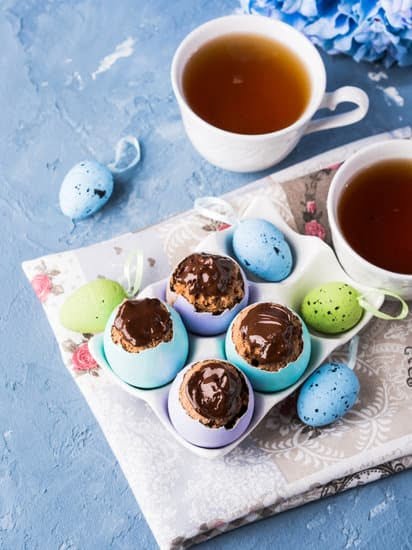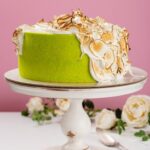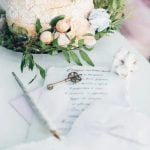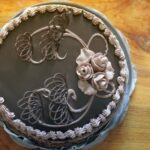In recent years, there has been a growing trend in the world of cake decoration – the use of real flowers. Gone are the days when artificial blooms were the go-to choice for adding a touch of elegance to cakes.
Now, more and more bakers and cake decorators are turning to nature’s own creations to adorn their sweet masterpieces. By incorporating real flowers, cakes are elevated with a natural and enchanting beauty that cannot be replicated by any artificial embellishment.
Using real flowers in cake decoration allows for a unique combination of beauty and delicacy. The vibrant colors, intricate petals, and intoxicating scents of fresh flowers can effortlessly transform a plain cake into a work of art.
From dainty wildflowers to bold blooms, the options are endless when it comes to selecting the perfect floral adornments for your cakes. Real flowers not only add an air of sophistication but also provide a connection to nature that resonates with those who appreciate organic elements.
When using real flowers to decorate cakes, it is essential to choose types that are safe for consumption. Certain varieties may contain toxic components or have been treated with pesticides that make them unsuitable for direct contact with food.
However, there are numerous flower options available that possess edible petals or non-toxic characteristics, ensuring both visual appeal and culinary safety. By carefully selecting these flowers and preparing them properly, you can ensure that your cake decorations not only look stunning but are also suitable for consumption.
As we delve deeper into exploring the world of decorating cakes with real flowers, we will guide you through the best types of flowers for this purpose and provide step-by-step instructions on preparing them for cake decoration. We will also share tips on choosing floral designs that complement different styles of cakes and showcase inspiring examples from professional cake decorators.
Additionally, we will address potential risks associated with using real flowers on cakes and offer safety precautions to avoid any adverse effects. So, let your imagination bloom as we discover the captivating art of decorating cakes with real flowers.
The Best Types of Real Flowers to Decorate Cakes
When it comes to using real flowers for cake decoration, it is important to choose the right types of flowers that are safe and suitable for consumption. Not all flowers are edible or non-toxic, so it is crucial to be mindful of this when selecting the floral elements for your cake. Here are some of the best types of real flowers that you can use to decorate cakes:
1. Edible Flowers:
Certain varieties of flowers have petals that are not only beautiful but also safe to eat. These flowers can be consumed without any harm and can add an exquisite touch to your cake designs. Examples of edible flowers include roses, pansies, marigolds, violets, and lavender. These flowers come in a range of colors and can be used whole or as individual petals for decoration.
2. Non-Toxic Flowers:
If you prefer a wider range of flower options, there are many non-toxic flowers that can be used on cakes as well. Non-toxic flowers may not have edible petals but pose no harm if they accidentally come into contact with food. Some popular non-toxic flower choices include carnations, daisies, sunflowers, tulips, and orchids.
Before incorporating any type of flower into your cake design, it is essential to research and verify its safety for consumption or contact with food. It is advisable to consult reputable sources such as florists or horticulturists who can provide accurate information about specific flower varieties.
Tips for Floral Selection
- Choose organic or pesticide-free options whenever possible.
- Avoid using any flowers that may have been treated with chemicals or pesticides.
- Make sure the chosen flowers do not have any natural toxins or irritants that could cause discomfort if ingested.
Remember that some people may have allergies or sensitivities to certain plants or pollen. It is recommended to check with anyone consuming the cake about any potential allergies before incorporating specific types of flowers.
Preparing Real Flowers for Cake Decoration
When it comes to decorating cakes with real flowers, proper preparation is key to ensuring both a visually stunning and safe final product. Follow these step-by-step guidelines to select and clean fresh flowers for cake use:
- Selecting the Right Flowers: Not all flowers are suitable for cake decoration. It is important to choose flowers that are safe to be consumed and have not been treated with harmful chemicals or pesticides. Opt for organically grown flowers whenever possible. Some popular choices for cake decoration include roses, marigolds, pansies, violets, and lavender blossoms.
- Cleaning the Flowers: Before using any flowers on a cake, it is essential to clean them thoroughly to remove any dirt, insects, or pesticide residue. Start by gently rinsing the flowers under cool running water to remove any visible dirt or debris. Avoid soaking the flowers as they can become waterlogged and wilted.
- Removing Pesticides: To ensure that the flowers are free from any pesticide exposure, soak them in a mixture of water and vinegar (1 part vinegar to 3 parts water) for about 15 minutes. This gentle solution helps eliminate any traces of pesticides without damaging the delicate petals.
- Checking Suitability: After cleaning the flowers, it is crucial to double-check their suitability for consumption. Ensure that no harmful bugs or fungi have settled on them during transportation or storage. Discard any damaged or wilted petals.
- Trim and Prepare: Once the flowers are deemed safe, trim their stems down to an appropriate length for cake decoration – usually around 2-3 inches – using clean kitchen shears or floral clippers. Remove any excess leaves or thorns that could potentially come into contact with the cake.
By following these steps, you can prepare your real flowers properly before using them for cake decoration, ensuring both a visually appealing and safe end result.
| Step | Description |
|---|---|
| Selecting the Right Flowers | Choose edible flowers that are safe for consumption and haven’t been treated with chemicals or pesticides. |
| Cleaning the Flowers | Gently rinse the flowers under cool running water to remove dirt and debris, avoiding soaking them. |
| Removing Pesticides | Soak the flowers in a mixture of water and vinegar (1 part vinegar to 3 parts water) for about 15 minutes to eliminate any pesticide residue. |
| Checking Suitability | Ensure that no harmful bugs or fungi have settled on the flowers before using them. |
| Trimming and Prepare | Cut down stems to appropriate length and remove excess leaves or thorns |
By following these steps, you can prepare your real flowers properly before using them for cake decoration, ensuring both a visually appealing and safe end result.
Choosing the Right Floral Designs for Different Cake Styles
When it comes to decorating cakes with real flowers, one important consideration is choosing floral designs that complement the style of the cake. Different cake styles call for different types of floral arrangements to enhance their overall aesthetic. Here are some tips on selecting the right floral designs for various cake styles.
For tiered cakes, which are known for their elegant and sophisticated look, delicate and cascading flower arrangements work best. Consider using flowers like roses, peonies, or hydrangeas to create a cascading effect down the sides of the tiers. These flowers add a touch of romance and luxury to the cake.
On the other hand, naked or semi-naked cakes have a more rustic and natural appeal. For these types of cakes, opt for wildflowers or seasonal blooms such as daisies, lavender, or chamomile. These flowers will complement the organic feel of the cake while adding a pop of color and texture.
If you’re decorating a whimsical or playful cake, consider using vibrant and unconventional flowers such as sunflowers or dahlias. These bold and eye-catching blooms can bring out the fun and lively spirit of the cake design.
| Cake Style | Recommended Floral Designs |
|---|---|
| Tiered Cakes | Roses, Peonies, Hydrangeas (cascading arrangement) |
| Naked/Semi-Naked Cakes | Daisies, Lavender, Chamomile (organic arrangement) |
| Whimsical/Playful Cakes | Sunflowers, Dahlias (vibrant and unconventional arrangement) |
Remember, the floral designs should enhance the overall aesthetic and theme of the cake. Experiment with different combinations and seek inspiration from professional cake decorators to create stunning floral arrangements that perfectly complement your chosen cake style.
Techniques for Safely Attaching Real Flowers to Cakes
Different Methods of Securing Flowers onto Cakes
When it comes to attaching real flowers to cakes, there are several techniques you can use depending on the desired effect and the type of flower you’re working with. One popular method is using floral wires or picks, which provide stability and make it easier to position the flowers exactly where you want them. To do this, gently insert a floral wire into the stem of each flower, making sure it goes through the base securely.
If your flowers have delicate stems or are too short for wires, you can also use food-safe picks. These can be inserted into the base of the flowers and then gently placed into the cake.
Another technique that is commonly used is using toothpicks or skewers as supports for the flowers. Simply attach a small piece of tape to one end of a toothpick or skewer and insert it into the base of each flower. Then, gently push the toothpick or skewer into the cake at an angle until it feels secure. This method works well for smaller, lightweight flowers that don’t require as much support.
Tips for Positioning Flowers on Cakes
To achieve a visually pleasing arrangement, it’s important to consider placement and balance when attaching real flowers to cakes. Start by determining where you want your focal point to be-a single large flower, a cluster of blooms, or even an asymmetrical design can work beautifully. Once you’ve decided on your focal point, begin positioning your flowers around it in a way that complements the overall design.
Consider using different heights and angles when attaching flowers to create depth and dimension on your cake. Experiment with placing some blooms closer to the surface while allowing others to cascade down delicately. You can also fill any gaps between flowers with greenery or leaves for added texture and visual interest.
Additional Tips for Safety
While real flowers can undoubtedly enhance the aesthetics of a cake, it’s crucial to ensure they are safe for consumption. Always use organic or pesticide-free flowers when decorating cakes, as pesticides can be harmful if ingested. Additionally, double-check that the flowers you choose are non-toxic and free from any chemicals.
To further prioritize safety, it is advisable to separate the flowers from direct contact with the cake by using a barrier like wax paper or plastic wrap. This will protect both the cake and the flowers. Remember that not all flowers are suitable for consumption, so be sure to inform your guests of any non-edible decorations on the cake.
By following these techniques and safety guidelines, you can confidently decorate your cakes with real flowers, creating stunning and eye-catching designs that will impress both visually and in taste.
Potential Risks and How to Avoid Them
Real flowers can add a beautiful touch to cake decorations, but it’s important to be aware of potential risks associated with their use. By taking the necessary precautions, you can ensure that your cake remains safe and enjoyable for everyone. Here are some key risks to consider and how to avoid them:
- Pesticide Contamination: One of the main concerns when using real flowers on cakes is pesticide contamination. It’s crucial to select organic or pesticide-free flowers to avoid any harmful chemicals coming into contact with the cake. When purchasing flowers from a florist or garden center, ask about their cultivation practices and if they are safe for food consumption.
- Allergies and Adverse Reactions: Some individuals may have allergies or sensitivities to certain types of flowers, pollen, or plant material. It’s essential to inform your guests about the presence of real flowers on the cake so they can make informed choices based on their dietary restrictions or allergies. Additionally, consider offering alternative desserts without flower decorations for those who may be at risk.
- Sanitation and Cleanliness: Properly cleaning and preparing the flowers is crucial in avoiding any potential contaminants. Start by choosing flowers that haven’t been sprayed with pesticides or other harmful substances, as mentioned earlier. Before using the flowers, gently wash them under cool running water while being careful not to damage delicate petals or blooms. Ensure that there are no visible dirt, bugs, or debris on the flowers before placing them onto the cake.
- Non-Edible Flowers: While many flower varieties are safe for decorating cakes, there are certain types that should never be used because they are toxic when consumed. Before incorporating any new flower into your baking repertoire, research its edibility thoroughly. For example, popular non-edible flowers include lilies of the valley, foxgloves, hydrangeas, and oleanders.
By being mindful of these potential risks and taking necessary precautions, you can confidently use real flowers as cake decorations. Remember to communicate clearly with your guests about the presence of real flowers and provide alternative options for those with allergies or dietary restrictions. With proper preparation and attention to detail, your cakes will be stunning and safe for all to enjoy.
Frequently Asked Questions about Decorating Cakes with Real Flowers
Many bakers and cake enthusiasts are curious about using real flowers for cake decoration, but may have questions or concerns. Here, we address some frequently asked questions to provide clarity and guidance on this trendy cake decorating technique.
Are there specific flowers that are safe to use on cakes?
Yes, not all flowers are suitable for cake decoration. It is important to use flowers that are edible and free from toxic substances. Some popular choices include roses, lavender, violets, pansies, marigolds, and chamomile. However, it is crucial to ensure that the flowers have not been sprayed with chemicals or pesticides before using them on cakes.
How can I ensure the flowers I use are safe for consumption?
To ensure the safety of the flowers you use for decorating cakes, it is recommended to source them from reputable suppliers who offer edible or organic flowers specifically grown for culinary purposes. Additionally, thoroughly clean the flowers by gently washing them under running water to remove any dirt or potential contaminants. It’s also advisable to remove the stamen and pistil from certain flowers as they may cause allergic reactions or bitterness.
Can I store cakes decorated with real flowers?
Cakes decorated with real flowers are best enjoyed fresh because the petals may wilt or discolor over time. If you need to store a cake adorned with real flowers, refrigerate it in an airtight container to help preserve its freshness and prevent any moisture from affecting the flower petals. However, it is always preferable to decorate your cakes with fresh flowers just before serving for optimal visual appeal.
Using real flowers on cakes can undoubtedly elevate their aesthetic appeal and make them stand out at any event. By following these guidelines and ensuring you choose safe floral options, you can confidently experiment with this beautiful and unique cake decorating technique.
Showcase
One of the most visually stunning ways to decorate a cake is by using real flowers. The use of real flowers in cake decoration has become increasingly popular, as it adds an elegant and natural touch to cakes. From simple buttercream designs to elaborate tiered cakes, real flowers can elevate the aesthetic and create a truly unforgettable centerpiece. In this showcase, we will explore some inspiring cake designs that feature real flower decorations.
Firstly, let’s delve into the world of minimalist cake designs. These cakes often have a clean and sophisticated look, with emphasis on using a minimal number of flowers for maximum impact.
For instance, a plain white cake adorned with a cascade of delicate pink peonies creates a picturesque display that exudes simplicity and elegance. Alternatively, pairing vibrant sunflowers with bright green foliage on top of a naked cake brings about an earthy and rustic charm that is perfect for outdoor weddings or garden-themed celebrations.
Moving on to more extravagant creations, tiered cakes offer the perfect canvas for showcasing an array of floral arrangements. A popular trend is incorporating cascading floral displays that flow from one tier to another. Imagine a towering three-tiered cake adorned with cascades of romantic roses and trailing greenery – it exudes grandeur and creates an impactful statement piece at any celebration.
Additionally, for those who prefer a more whimsical style, consider combining wildflowers such as daisies and lavender with delicate blossoms like baby’s breath or jasmine. This enchanting combination gives off an ethereal vibe that is perfect for bohemian or fairy tale-inspired events.
To achieve these stunning visual effects while ensuring the safety of the flowers, it is essential to prepare them properly before decorating the cake. Make sure to select fresh flowers from reputable sources and give them a thorough rinse to remove any dirt or pesticides.
It is also vital to ensure that the flowers you choose are safe to consume and don’t have any toxic properties. Consulting with a florist or doing research on safe flowers for edible use will help guide you in selecting the right blooms for your cake.
Conclusion
In conclusion, decorating cakes with real flowers is a fantastic way to elevate your cake decorating game and add a touch of natural beauty and elegance to your creations. The rising trend of using real flowers in cake decoration is not only visually stunning but also allows for endless possibilities in creating unique and personalized designs.
Throughout this article, we have explored the best types of flowers to use for cake decoration, providing options with edible petals or non-toxic characteristics. We have also discussed how to properly prepare real flowers for cake use, ensuring they are safe and suitable for consumption. Additionally, we provided guidance on choosing floral designs that complement different cake styles and techniques for safely attaching the flowers.
While there are potential risks associated with using real flowers on cakes, such as pesticides or allergies, we shared safety precautions and addressed common concerns. It’s important to always clean the flowers thoroughly and remove any non-edible parts before placing them on the cake.
Lastly, we showcased a collection of inspiring cake designs decorated with real flowers, featuring the work of talented professional cake decorators who have mastered the art of incorporating floral elements into their creations. We hope these examples serve as inspiration for readers to experiment with their own unique designs.
Incorporating real flowers into your cake decoration not only adds a stunning visual element but also brings a touch of nature’s beauty to your culinary creations. Whether it’s a simple buttercream birthday cake adorned with delicate blossoms or an extravagant tiered wedding cake embellished with vibrant blooms, using real flowers can truly elevate the overall aesthetic and make your cakes stand out.
So why not try it yourself? Let your creativity bloom and unleash your inner artist by embracing the natural elegance of decorating cakes with real flowers.
Frequently Asked Questions
Can you use real flowers to decorate a cake?
Yes, it is possible to use real flowers to decorate a cake. However, certain precautions need to be taken to ensure they are food-safe and do not pose any health risks. First, it is important to make sure that the flowers have not been sprayed with any pesticides or chemicals that could be harmful if ingested.
It is also crucial to choose edible flowers that are safe for consumption. While many common flowers such as roses, violets, and marigolds can be used on cakes, it is advisable to consult a reputable source or a florist knowledgeable in edible blooms before using any specific flower.
How do you decorate a cake with fresh flowers?
Decorating a cake with fresh flowers can add a beautiful and natural touch to your creation. To start, thoroughly clean each flower by gently rinsing them under cool water and removing any dirt or insects carefully. Once the flowers have been properly cleaned and prepped, they should be arranged on the cake right before serving to prolong their freshness.
To avoid direct contact between the blooms and the cake’s surface, you can place parchment paper or cellophane wrap over the frosting before arranging the flowers on top. This will help prevent any potential transfer of contaminants from the flowers onto the cake.
What real flowers are safe to put on a cake?
When considering real flowers for cake decoration, it is essential to select species that are safe for consumption. Some common choices include roses, pansies, violets, marigolds, lavender blossoms, chamomile blossoms, hibiscus petals (especially dried ones), and carnations. However, it is crucial to check if these particular flowers are sourced from organic growers or are pesticide-free before using them on food items like cakes.
Furthermore, remember that not all parts of a flower may be edible – for example, stamens or pistils might need removal depending on the variety chosen. Always consult reliable sources or experts who can provide accurate information about which real flowers are safe for use on cakes.

Welcome to our cake decorating blog! My name is Destiny Flores, and I am the proud owner of a cake decorating business named Cake Karma. Our mission is to provide delicious, beautiful cakes for all occasions. We specialize in creating custom cakes that are tailored specifically to each customer’s individual needs and tastes.





